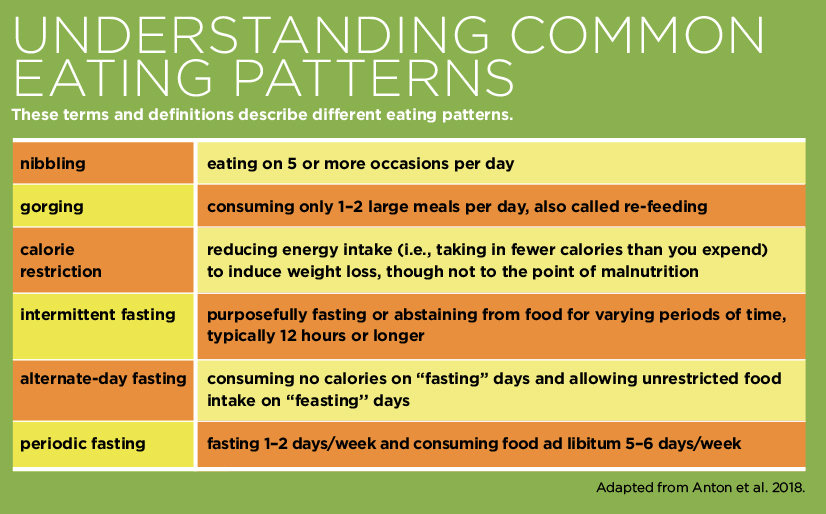Myths About Meal Timing and Frequency
Replace the top five meal frequency and timing myths surrounding small meals and fasting with evidence-based, client-friendly recommendations.
| Earn 1 CEC - Take Quiz

Which is better: eating five or more small meals or fasting for 16 hours a day? There are a lot of opinions about the optimal meal timing. Whether your clients are trying to lose weight or gain muscle, chances are they have heard of meal frequency and meal timing, which are common terms used interchangeably to talk about dietary eating patterns. However, all the talk has created a mythology around the “right” way to eat. It’s time to separate myth from reality by looking beyond opinions and focusing on the science.
The top five meal-timing myths cluster around the value of fasting compared with eating frequent small meals in relation to metabolism, muscle mass and body composition. Overlay these elements with the realities of client goals, lifestyles and sustainability, and you can see why myths arise. Once you uncover the truth about meal frequency, you will be empowered to confidently discuss the general health relevance of meal frequency and fasting with your clients.
Meal Timing for Metabolism and Energy Balance
The top five myths are often based on misinformation about how food (calories) is used by the body. Common meal patterns that adjust meal frequency include nibbling, fasting and gorging. Nibbling throughout the day typically refers to eating five (or more) small meals per day, while gorging (also called feasting) is indicative of eating one or two larger meals per day. These meal patterns are intended to affect metabolism and energy balance.
Metabolism is technically the metabolic rate, which is the number of calories the body burns during a given time period (for example, 2,000 calories/day). There are a handful of things that meaningfully influence metabolism, including age, gender, medications, hormones and quantity of muscle mass. Some we have control over (such as muscle mass), and some we don’t (such as age).
Energy balance is the relationship of calories we consume (taken in through food and beverages) with calories we expend (via metabolic rate plus physical activity). When individuals want to lose weight, they must consume fewer calories than they burn; vice versa to gain weight. Of course, there are exceptions to any rule, but for the majority, this is true.
Researchers, meanwhile, are still working to determine how different meal frequency patterns impact metabolism. Results from any changes in our eating patterns can vary drama­tically based on body composition goals, athletic performance and personal preference.
“It is easy for patients/clients to get enticed into thinking the popular trend of the moment is going to be the magic bullet for them,” says Faith Shevlin, MS, RDN, senior manager of clinical programs for inHealth Medical Services Inc. “That is often not the case. Meal timing, frequency and patterns must be approached individually with each client. We must explore patterns around sleep, mood, hormones, energy, work-related demands, schedules and nervous system stability to determine what is going to be optimal in supporting their unique body and metabolism most effectively.”
See also: The Food-Inflammation Connection
Myth #1: Eating Frequent Smaller Meals Spikes Metabolism
This myth proposes that eating five or more smaller meals a day (nibbling) will raise metabolic rate, which will burn more calories. Can we change our eating patterns to tip the metabolic scale in our favor?
BACKGROUND
This myth surfaced because it is true that when you eat you increase your metabolic rate slightly by increasing the thermic effect of food (that is, calories burned from consuming food). However, the additional number of calories burned is minimal: <10% of the total amount of calories you burn in a day (that is, only 200 more calories if you are consuming 2,000 calories per day).
THE EVIDENCE
The idea that eating many small meals per day can increase your metabolism, or prevent it from “slowing down,” is a myth that has been challenged by researchers. Kinabo and Durnin (1990) found decades ago that when energy intake is equal between two diets (nibbling or gorging), the net thermic effect of food is also equal, regardless of meal frequency. This was further confirmed by researchers using a “gold standard” metabolic/respiratory chamber comparing nibbling, gorging and fasting meal frequency patterns (Smeets & Westerterp-Plantenga 2008; Seimon et al. 2015).
THE TAKEAWAY
Just as with any other desired outcome, professionals must use client goals and personal preferences to adapt recommendations for individual clients. At the end of the day, evidence shows that metabolic rate is not affected by altering meal frequency, so help your clients choose a pattern that safely reduces caloric intake for them.
Myth #2: Eating Frequent Smaller Meals Reduces Hunger

Meal size may not control appetite since food cravings are initiated by multiple factors, like hormones and circadian rhythms.
We all have cravings from time to time. Can you think about a time when you were ravenous and all you wanted was a cheeseburger (or any other high-fat, high-calorie food)? What if we could keep those temptations at bay with dietary manipulation?
While increasing the number of occasions for eating may not affect metabolic rate, some believe it helps control appetite and improve glucose/insulin metabolism, thereby reducing cravings. By comparison, eating larger meals is thought to result in rapid highs and lows in blood sugar levels, which could cause cravings.
BACKGROUND
Current research does not necessarily support these beliefs. What’s the cause of food cravings? It turns out that hormones found in the gut and adipose tissue may be the underlying culprit. Insulin and glucose do have an effect on the body’s hunger and satiety hormones (ghrelin, which stimulates the appetite, and leptin, which among many other satiety hormones regulates energy balance). Ghrelin is the only hunger hormone: It acts fast and hits like a powerhouse to stimulate hunger from the gut and trigger the central nervous system, prompting us to eat.
The gastrointestinal hormones, including ghrelin, are among the main influencers of feeding behavior. They drive whether we’re motivated to be a nibbler or a gorger, to enjoy breakfast (or not), or to experience food cravings. Food cravings are initiated by multiple factors, including a person’s habits, hormones and circadian rhythms (Hutchison & Heilbronn 2016). As the body’s internal body clock, circadian rhythms play a unique role in nutrient metabolism, behavioral responses, core temperature and the release of appetite hormones (Peeke 2018).
Some people have higher amounts of ghrelin. Telling someone with naturally high ghrelin levels to reduce their eating frequency can create “hangry” emotions.
THE EVIDENCE
The research is not definitive. Increasing meal frequency to a level that is higher than what you are used to may actually increase your hunger, according to some reports (Ohkawara et al. 2013). Overall, this is directly associated with BMI (body mass index). Research shows that, on average, as BMI increases, circulating ghrelin levels decrease—while circulating leptin levels increase (Monti et al. 2006).
THE TAKEAWAY
This suggests that for clients with higher BMIs, reduced eating frequency or even a fasting program could help them attain calorie and macronutrient targets. It’s best to advise clients to listen to their internal clocks, and to promote an eating pattern that encourages consumption of quality calories with adequate protein. This approach is likely to reduce cravings during a negative calorie balance.
Myth #3: Eating Multiple Times per Day Boosts Muscle Mass

If the goal is to increase mass or build muscle, eating more frequently may be an effective approach.
We know that diet has a lot to do with weight and that what we eat affects our body composition (percentage of body fat and lean weight). But many believe that a higher meal frequency promotes fat loss and muscle gain more effectively than a lower meal frequency. When examining these common beliefs, turn to the evidence from larger clinical studies.
THE EVIDENCE
The research is clear. Fasting intermittently and reducing caloric intake (by nibbling or gorging) are both valid ways to lower body weight, resulting in similar changes in body composition (Seimon et al. 2015). Based on the cumulative results of multiple studies, researchers concluded that the two diet types result in “apparently equivalent outcomes” in terms of body weight reduction and body composition changes when adequate protein needs are met (Aragon et al. 2017; Seimon et al. 2015).
So, what’s the real differentiator? It’s calorie balance. The reality is people think they are eating less than they really are. Even when counting calories, people underreport what they eat an average of 47% of the time and overreport physical activity about 51% of the time (Lichtman et al. 1992). When you combine these two, we are almost doubling the caloric load!
THE TAKEAWAY
Both small, frequent meals and fasting can help clients lose weight as long as appropriate calorie and macronutrient goals are attained.
In general, if clients are trying to lose weight, lowering meal frequency may be helpful because it allows fewer opportunities to eat. Data supports reducing nibbling occasions to limit the chance of underestimating how much is eaten. This, in turn, may help with reducing total calorie intake.
If the goal is to increase mass, build muscle or hone physique, eating more frequently may be a better approach. For example, if your client needs to consume 4,000 calories per day, it may be easier to spread out those calories in five meals (800 calories/meal) versus packing consumption into one large meal of 4,000 calories or two of 2,000 calories.
See also: Nutrition Misfires
Myth #4: Fasting Is Best for Increasing Fat Metabolism

While fasting increases fat mobilization, the key is to identify sustainable lifestyle habits for clients.
Intermittent fasting, and other fasting protocols, have made their way into the mainstream. Fasting as a remedy for medical ailments dates back to the times of Ancient Greeks, Chinese and Romans. Even Benjamin Franklin and Mark Twain suggested fasting for medical reasons. Is there a difference between reducing calories evenly throughout the week (calorie restriction) and fasting (reducing intake for an extended duration) with regard to fat metabolism? The fight over which is the better approach has been, and is still, a very controversial topic.
Caloric restriction is the act of reducing energy intake (typically 20%–40% fewer calories consumed than calories expended); fasting is a controlled abstinence from food (abstaining then feasting).
Intermittent fasting is a term used to describe a variety of eating patterns in which no or few calories are consumed for time periods that can range from 12 hours to several days on a recurring basis (Anton et al. 2018). Fasting plans include alternate-day fasting and periodic fasting, with individual program variations ranging among ratios of 12:12, 16:8, 20:4 and 24:0 (fasting:feasting hours). People have been experimenting for decades with fasting’s effects on metabolism.
THE EVIDENCE
Anton et al. discuss intermittent fasting as a superior method for overweight adults because of the fat mobilization benefits that kick in as the body switches to fat as a source of fuel. The authors describe this as the “metabolic switch,” which they suggest occurs after about 12 hours of fasting (at the point of negative energy balance) when liver carbohydrates stores are depleted and fat metabolism must take over. The authors describe this adaptation as occurring with habitual intermittent fasting practices. While the impact of habitual fasting on gut hormones is still controversial, some researchers believe physiological ketones produced during extended fasting can play a role in fat metabolism by mitigating the ghrelin increases that typically occur during fasting as compared with standard energy restriction (Hutchison et al. 2019). However, there have been reported risks with extended fasting (several weeks or more), including nausea, dizziness, abnormal liver function, decreased bone density, and thiamine deficiencies (Anton et al. 2018).
Intermittent fasting isn’t the only way to tap into fat metabolism. Caloric restriction has been shown time and time again to increase fat mobilization, especially in combination with exercise (Cherif et al. 2016). For fitness pros examining intermittent fasting in physically active versus sedentary individuals, the focus should be goal-oriented, with energy metabolism as a secondary consideration. Both exercise and nutrition influence fat metabolism, but exercising while fasting, for example, can be a genuine challenge for athletes’ cognitive function and physical performance, including their high-energy explosive power (Cherif et al. 2016). Any potential benefits from fasting can be undone if caloric and macronutrient targets (carbs, fats and proteins) are not adequate.
THE TAKEAWAY
We are either storing food energy or burning food energy.
Therefore, to manipulate body weight up or down, we need to manipulate the energy balance equation. Overall, both calorie restriction and fasting can considerably reduce caloric intake and bring about similar health benefits. They are like cousins in a way, particularly because fasting studies emerged from work on caloric restriction.
The important point when discussing intermittent fasting, believes Len Kravitz, PhD, program coordinator of exercise science at the University of New Mexico and international speaker on fat metabolism and weight management, is working with a client to identify the “sustainable lifestyle habits that can lead to weight loss success,” he says. “The key is what will work for a client over the long run to successfully help them attain their goals.”
Myth #5: We Need to Time Nutrient Intake

For most people trying to look and feel better, nutrient timing may overcomplicate their lifestyle shift.
Is nutrient timing the same thing as meal frequency? Nutrient timing is a strategy to consume nutrient combinations, especially of protein and carbohydrates, around an exercise session. Meal frequency refers to how often food is consumed.
There can be an interplay between these concepts. Chad Kerksick, PhD, associate professor at Lindenwood Uni┬¡versity in St. Charles, Missouri, and author of Nutrient Timing: Metabolic Optimization for Health, Performance, and Recovery (CRC Press 2011), says, “In its purest form meal frequency is an example or component of nutrient timing. Nutrient timing historically has been reserved for pre-, during, and postexercise, but other important questions like meal frequency, protein patterns, and nighttime feeding have forced an expansion of what traditionally is considered to be nutrient timing.”
THE TAKEAWAY
Timing the consumption of specific nutrients can be an important way for athletes to ensure that their protein or carbohydrate intake is enough to support muscle recovery and to replenish energy stores. But for most people trying to look and feel better, adopting this strategy could overcomplicate an already difficult and demanding lifestyle shift. Timing our food intake is more of a fine-tuning strategy that can be used after energy and macronutrient goals are established. We can always try to help our clients select the right pre- and postworkout meals, but that might be something we introduce down the road.
The 5 Myths About Meal Timing Exposed

Discuss the facts behind meal timing myths to help your clients improve their diet strategies.
Share the truths that debunk myths about meal timing to guide clients toward meeting their goals.
1. MEAL FREQUENCY
Available literature states pretty firmly that increasing your meal frequency does not have a metabolic advantage. It’s important to reiterate to your clients that if increasing the frequency of their meals helps them attain calorie goals, great! But if they have a hard time with meal planning and counting calories, this method may do more harm than good.
2. FAT METABOLISM
Fasting will, by the laws of energy metabolism, increase the amount of energy being utilized from fat. However, fasting protocols may be beneficial for some populations and not for others. For some populations, fasting can be a great alternative to stay on the path to attaining calorie goals. However, especially for very active clients or athletes, there may be performance repercussions.
3. HUNGER
Intermittent fasting is equivalent to continuous energy restriction. Since many factors regulate hunger hormones, it may be best to focus on diet quality and caloric targets instead of eating patterns.
4. BODY COMPOSITION
Currently, the evidence does not support an added benefit of increased meal frequency for long-term body composition goals. For a lower-calorie diet, a pattern of eating fewer meals may reduce the risk of underreporting food intake.
5. NUTRIENT TIMING
This is the cherry-on-top of eating patterns. The first step is to focus on overall energy goals, macronutrient aims and exercises that support muscular fitness (for optimal body composition). The timing of nutrients can then be introduced in more specialized discussions once tracking, calories and macronutrients are in place.
See also: Analyze Today’s Hot Button Issues in Nutrition
Lifestyle Rules Eating Patterns
If you’re a dietitian or health coach working with clients, it’s certain that you will get questions related to meal frequency. The bottom line is that many client goals may be attained by limiting the number of calories being consumed. Caloric restriction—whether from one meal or five—helps clients stay on target. We need to motivate clients to decide on the right meal pattern for them, as part of a plan that supports them both physically and mentally.
The most effective meal frequency depends on each person’s unique biochemistry, medical status and circadian rhythms. When it comes to nibbling, gorging or fasting, there is definitely not a one-size-fits-all approach. As Kerksick notes, “If some clients can nibble and that works for them to manage hunger and achieve their goals, do it! If another client needs big cheat meals or re-feeds (gorging) to psychologically unload after a strict week or two of training and calorie cutting, do it! Studies clearly show that frequency takes a backseat to a caloric deficit.”
Experts agree that meal patterns should be client-centered and adaptable in order to drive long-term lifestyle change. When trainers understand their clients, build rapport and tailor client needs to goals, both trainers and clients can win. Use the meal pattern map as a discussion guide to help you find the right fit for your clients.
Meal Pattern Map
Use the meal pattern map to properly guide clients with questions on setting a meal pattern:
- Set calorie goals. Make calorie recommendations specific to goals.
- Suggest adequate protein. Use gram-per-kilogram-of-body-weight recommendations that are specific to goals.
- Investigate other macronutrient targets. Take a deeper dive into fat and carbohydrate requirements.
- Review meal frequency. Look at current behavior and evaluate if nibbling, gorging or fasting would be best to achieve goals.
- Time nutrient intake (optional). Fine-tune for performance or goals as appropriate.
References
Anton, S.D., et al. 2018. Flipping the metabolic switch: Understanding and applying the health benefits of fasting. Obesity, 26 (2), 254–68.
Aragon, A.A., et al. 2017. International Society of Sports Nutrition position stand: Diets and body composition. Journal of the International Society of Sports Nutrition, 14 (16).
Cherif, A., et al. 2016. Effects of intermittent fasting, caloric restriction, and Ramadan intermittent fasting on cognitive performance at rest and during exercise in adults. Sports Medicine, 46 (1), 35–47.
Hutchison, A.T., & Heilbronn, L.K. 2016. Metabolic impacts of altering meal frequency and timing—Does when we eat matter? Biochimie, 124,
187–97.
Hutchison, A.T., et al. 2019. Effects of intermittent versus continuous energy intakes on insulin sensitivity and metabolic risk in women with overweight. Obesity, 27 (1), 50–58.
Kinabo, J.L., & Durnin, J.V. 1990. Thermic effect of food in man: Effect of meal composition, and energy content. British Journal of Nutrition, 64 (1), 37-44.
Lichtman, S.W., et al. 1992. Discrepancy between self-reported and actual caloric intake and exercise in obese subjects. The New England Journal of Medicine, 327 (27), 1893–98.
Monti, V., et al 2006. Relationship of ghrelin and leptin hormones with body mass index and waist circumference in a random sample of adults. Journal of the American Dietetic Association, 106 (6), 822–28.
Ohkawara, K., et al. 2013. Effects of increased meal frequency on fat oxidation and perceived hunger. Obesity, 21 (2), 336–43.
Peeke, P.M. 2018. Is it time to eat yet? Fitness Journal, 15 (7), 30–38.
Seimon, R.V., et al. 2015. Do intermittent diets provide physiological benefits over continuous diets for weight loss? A systematic review of clinical trials. Molecular and Cellular Endocrinology, 418, 153–72.
Smeets, A.J., & Westerterp-Plantenga, M.S. 2008. Acute effects on metabolism and appetite profile of one meal difference in the lower range of meal frequency. British Journal of Nutrition, 99 (6), 1316–21.
Michelle Alencar, PhD
Michelle Alencar, PhD, is an associate professor in kinesiology and also serves as co-founder and Chief Science Officer for inHealth Lifestyle Therapeutics, Inc. She is a certified clinical nutritionist, certified lifestyle therapeutics health coach, exercise physiologist and strength & conditioning specialist with a passion for mobile health and virtual lifestyle coaching. She has several research publications in the areas of health, mobile health, telemedicine and body composition.







